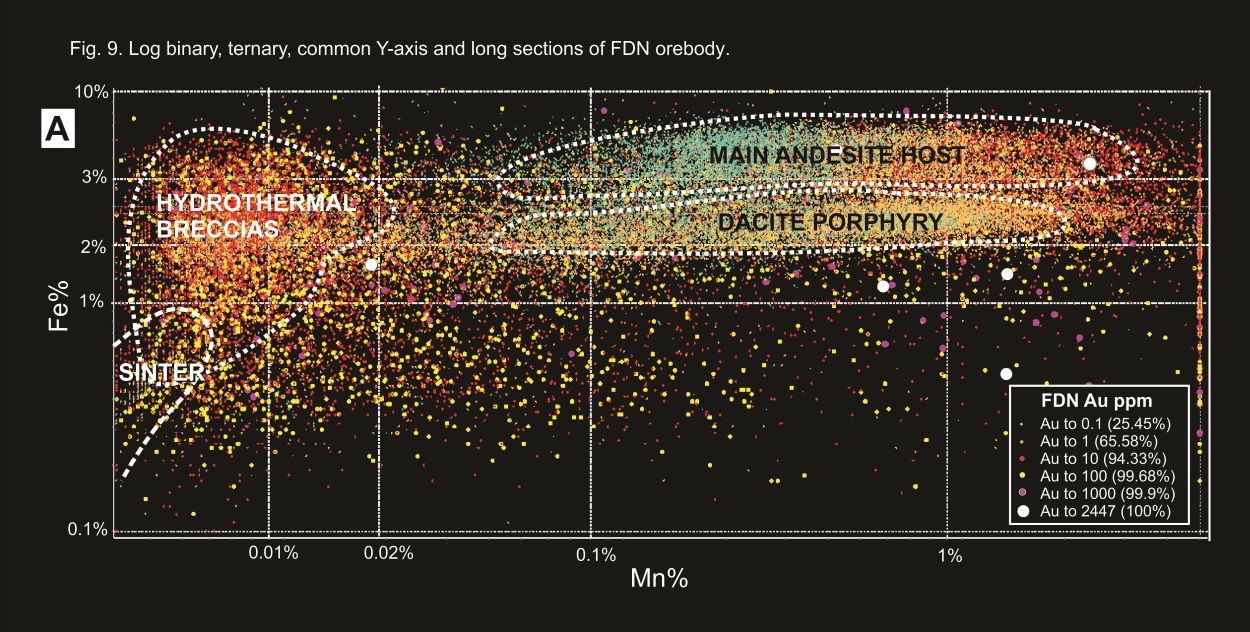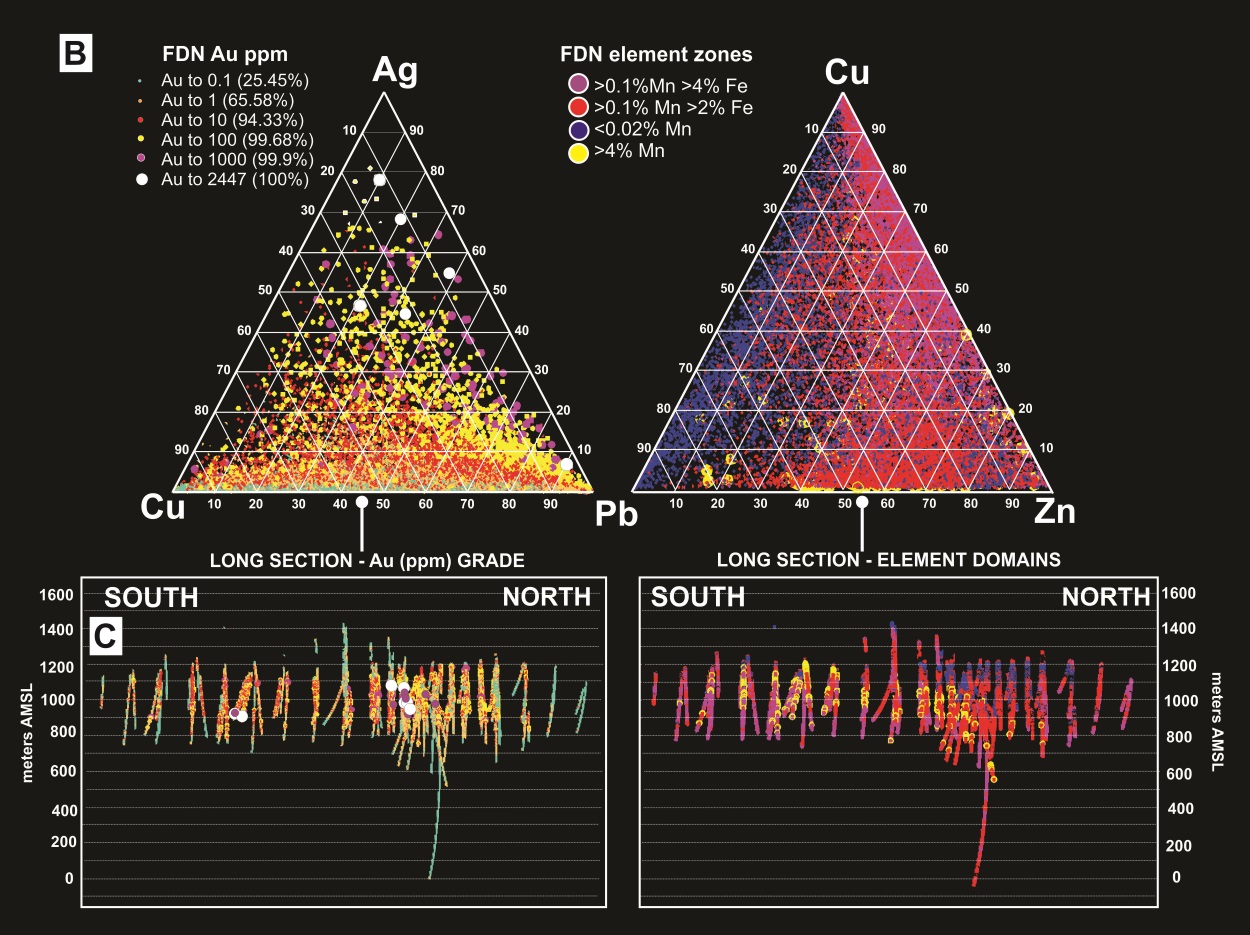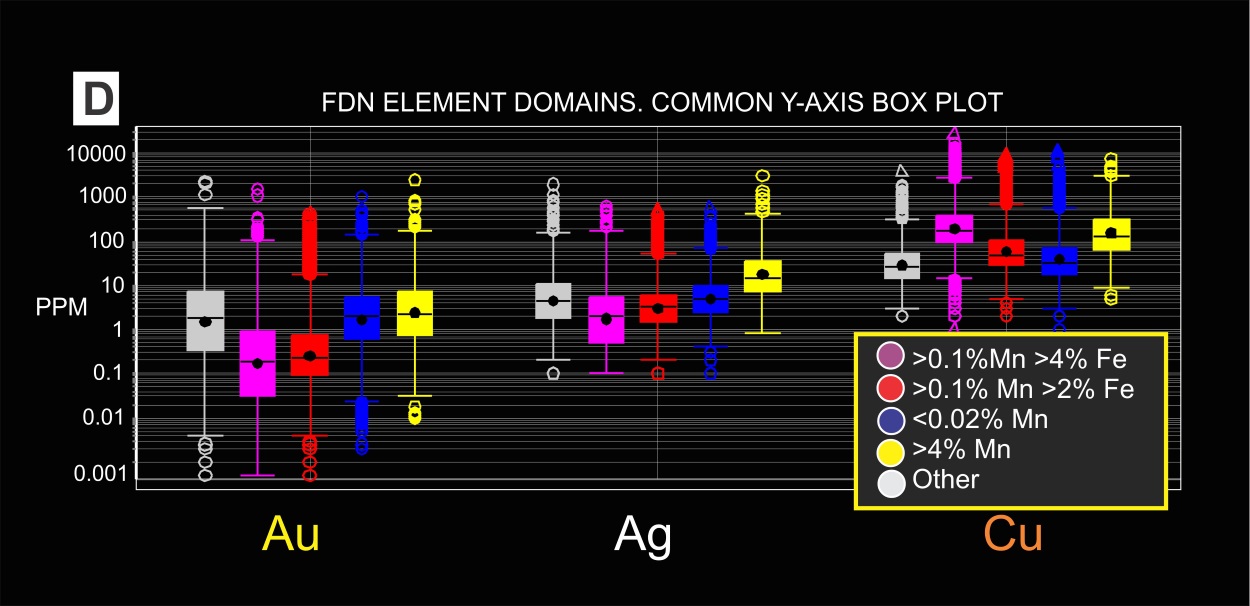
Fig. 1. (A) Plate tectonic context of Ecuador. (B) Summary regional geological map of south-eastern Ecuador with main mineral deposits abbreviated as C: Chinapintza, M: Mirador, N: Nambija, P: Panantza, SC: San Carlos, SL: San Luis and W: Warintza. (C) One of the numerous chalcedonic boulders that accumulated in drainages directly above FDN. In conjunction with other exploration criteria, these boulders formed important components of the targeting strategy (Leary, 2005) that lead to the discovery of FDN in 2006 (Leary et al., 2007). (D) Drill core of geyserite and stromatilitic deposits. (E) Drill core of laminated silica sinter located in basal conglomerates above FDN. (F) Macro-band of visible gold with acanthite (Ag2S) in manganoan carbonate (MnCO3). (G) Beads of visible gold and silver in brecciated ginguro. (H) Panorama looking west (from El Tigre) across the flat-topped Hollín mesas towards the FDN ore body. Age data for FDN are from Stewart, (2009). (I) Porphyry Cu alteration/mineralization in the form of centre-line pyrite-chalcopyrite D-veinlets at the base of FDN. ▼

Fig. 2. FDN is hosted in batholith-bound sequences of andesitic to dacitic lavas, tuffs and other volcaniclastic rocks that constitute part of the Piuntza unit of the Santiago Formation. (B) The total alkali versus silica classification of Wilson, (1989) shows the high K, calc-alkaline nature of the Zamora batholith proximal to FDN. Here it comprises syeno-diorite and diorite with lesser quartz diorite and granite. A typical diorite is pictured (in A) adjacent to a darker dike of equivalent composition from El Tigre drill core. Flanking FDN to the east and northeast the diorites show locally significant porphyry-style Cu and Au mineralization such as the Camp and Tranca Loma porphyry bodies. In addition, the batholith is often cut by narrow, late-stage aplite dikes and, further afield, by larger dikes of basaltic composition. Lamprophyre dikes have also been detected in drill core from beneath FDN.
(C) Primordial mantle normalized values of batholith samples illustrated by spider diagram show how the most incompatible or large ion lithophile elements (LILE) such as Cs, Rb, Ba and, to a lesser extent, Sr are enriched relative to high field strength elements (HFSE), suggestive of the significant involvement of crustal fluids in the genesis of the Zamora batholith (e.g., by slab dehydration). Lead, which is also LILE, produces a more striking positive anomaly, plausibly indicative of crustal contamination, perhaps by the excessive amounts of sediment incorporated into the subduction zone. Note from figure 1a how the subducted oceanic plate opposite FDN is substantially thickened by the aseismic ridges south of Carnegie Ridge. Some authors suggest that the subduction of such thickened crust triggers the production of metalogenically fertile supra-subduction environments (Rosenbaum et al., 2005). Negative Nb, Ta, and Ti anomalies are characteristic of subduction-related magmas, although their exact significances remain open to debate.
(D) Chondrite normalized REE distributions show relatively steep LREE element distributions (enriched in La and Ce) and less inflected HREE patterns. In combination with the strong LILE enrichment shown in C, these patterns further indicate that continental crustal materials significantly contaminated the magmas during their ascent. A moderate negative Eu anomaly underscores the fractionation of plagioclase during the formation of these magmas.
(E and F) The ratios between Sr and Y of intrusive rocks from various locations along the batholith and in particular, proximal to the Suárez pull-apart basin, do not define a prominent porphyry-style signature. Samples are lacking however, from the Camp and Tranca-Loma porphyry centers underlying Fruta del Norte. High Sr/Y ratios in intrusive rocks can be associated with sulphur and volatile-rich, oxidized magmas (e.g., Rohrlach et al., 2005; Richards et al., 2012). ▼

Fig. 3. (A) Scaled cross section of the cover sequences above the FDN orebody, showing their geological and metallogenic characteristics. (B) Ikonos image with summary geology of the Zarza/Machinaza river areas, illustrating the location of FDN at the northern part of the Suárez pull-apart basin. ▼

Fig. 4. The Cóndor Project, instigated in 2001 by Aurelian Resources, comprises a wealth of multi-element assay data derived from drainage samples, soil sample grids, and rock samples from various geochemical prospecting campaigns by Aurelian and by predecessor mining companies such as Climax Mining NL and, to a lesser extent, by Newmont Mining. All sample media by Aurelian were prepared by Agua Regia digest for ME-ICP analyses with fire assay gold. In this section, we compare the percentile overlap (at >80th percentile) of traditional gold pathfinder elements such as As, Sb, Hg etc. among a number of follow-up soil geochemical grids. Some of these targets, such as the El Tigre and Papaya, were drill tested by Aurelian in 2007 but did not yield significant results. Other targets such as Emperador, Maicu, and the eastern part of FDN itself represent epithermal and possible Carlin (in the case of Maicu) styles of mineralization. ▼

Fig. 5. Weathering index diagrams (A-CNK) of Nesbit and Young (1989) showing the spectrum of rock samples, mostly chips, collected by Aurelian Resources over the extent of the Cóndor Project between 2001 and 2007. These are compared with FDN core samples. The weathering index diagrams are useful for tracking the compositions of feldspar-rich rocks and their reductions to weathering products. The data distributions are influenced however, by the digest method (agua regia), which partially dissolves rock-forming silicates and does not dissolve refractory phases. End member mineralogy and rock types as follows: And - Andesite, Bio - biotite, Bas - Basalt, Chl - Chlorite, Fspar - Feldspar, Hbl - Hornblende, Musc - Muscovite, Rhy – Rhyolite. ▼

Fig. 6. Spatial overlaps of Au, Ag and Cu with other pathfinder and commodity elements are depicted thematically from stream sediment and rock samples using RGB homogenization in ioGAS. Gold and its traditional pathfinder elements define coherent clusters at the juncture of the Rio Blanco and Las Peñas Fault Zones. Anomalism as such continues southward along the eastern limits of the Suárez pull-apart basin.. Note how the association Cu-Mo-S delimits the southern end of the Mirador Cu-Au Porphyry District. ▼

Fig. 7. Alteration Indices for rock and stream sediment samples. The potassic alteration index further illuminates the extents of porphyry-style mineralization along the Las Peñas Fault Zone. Ishikawa and Sericite Indices are elevated along the entire fault traces with peaks correlative with the arrangement of known Au and Ag targets. ▼

Fig. 8. Gold grade histograms and element domains of FDN. There are several distinctive mineral zones within the FDN orebody, of which the lower manganoan carbonate zone (shown in figure 1F and G) contains most of the known gold and silver resource. The zonation of the Mn carbonates is clearly distinguished in B. Above these is a dense zone of dark chalcedony marcasite, itself capped by a relatively thin sulphide-depleted carapace showing the highest average Au grades (averaging 12.53 g/t Au Eq). The northern part of the orebody is demarcated by a Mn-depleted zone of oftentimes bladed quartz-carbonate (hosting electrum), separated from the rest of the ore-body by a healed fault. The first inferred mineral resource was estimated at 13.7 million ounces of gold @ 7.23 g/t Au and 11.8 g/t Ag for 22.4 million ounces of contained silver at a cut-off grade of 2.3 g/t gold-equivalent (Hennessey et al., 2007). ▼



Fig 9. (A) Log binary plot of Mn% and Fe% concentrations in FDN (with Au size and color ramps) showing three distinctive data clouds around which the main host units can be constrained chemically. Allowances need to be made for some overlap between the data clusters. Hydrothermal breccias, although visible in most of the mineral domains, are confined to the lower Mn continuum (<200 ppm Mn), while spanning order of magnitude Fe concentrations. The host andesites occupy the upper tier cloud, spanning several order of magnitude Mn concentrations, while the distinctive dacite porphyry in the footwall occupies the lower tier cloud below this. Sinter, while not forming an integral part of the mineral resource inventory, is largely confined to the lower Fe and Mn percent scale, although grades of up to 92 g/t Au are not uncommon in sinter. (B) Ternary diagrams for Au, Ag and Pb as well as Cu, Pb and Zn explore the intrinsic variations in Au grade and the affinities of the ores, and the multiphase nature of the epithermal fluids that deposited them. The north- south long sections in C show down-hole drill data (to 2008) expressed as Au grade and element zones. Note the singular deep drill hole (1340 m deep) that was used to explore for a hypothetical offset portion of the ore body west of the West Fault. (D) Common y-axis box plot showing the ranges of metal values in FDN ore for each element domain. ▼

Fig. 10. Leapfrog interpolants of FDN. These were generated from 42,275 drill core sample points, typically 1 m length half core splits, obtained to April 2008. These data were released to the public domain by Aurelian Resources Inc. (A) Long sections and cross sections of the FDN orebody showing the concentric Au grade zonation and the coherent northern zone of bonanza grade (10-100 g/t Au), which includes 140 samples grading between 100 and 2447 ppm Au. The West Fault is a narrow (1-2 m) cohesive gouge zone forming a hard grade break, whereas the East Fault Zone is defined by broad 30-50 m zone of complex fault strands disrupting zones of peripheral mineralization. (B) The FDN Horse Block is a distinctive, seemingly dislodged block of mineralization, located in the northern part of the orebody and measuring approximately 75 x 80 x 150 m in dimension. This portion of the mineralized system appears to have been wrenched out of place during a major faulting event and is termed a "horse” or “horse block” from antiquated miners terminology. Note how the shape of the high grade zone refracts around the FW dacite porphyry. Disperse Au-Ag mineralization is detected on the opposite side of this dacite porphyry body, suggestive of the repetition of FDN at some scale. (C) Plan of the orebody showing the extent of the lower Mn stockworks zone and the tight fault-control on the distribution of Au mineralization. (D) Isometric representation of the ore-body showing the distinctive Mn-depleted northern quartz-carbonate vein zone and lower Mn carbonates. The orebody continues diffusely to the south as Bonza-Las Peñas where an additional mineral inventory exists of 0.5 million ounces of Au. (E) Cross sectional renderings showing gold grades in relation to As, Sb, and Mn. These particular interpolants show blow-outs (artifacts) west of the West Fault where assay data are deficient. ▼
Back to top